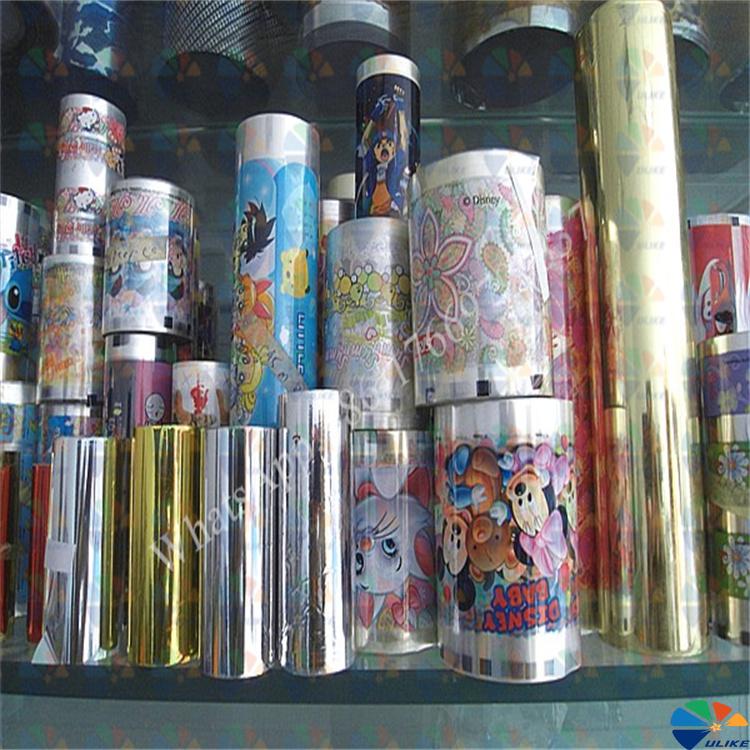Only 5 points are needed to easily master the quality inspection of thermal transfer films
Only 5 points are needed to easily master the quality inspection of
thermal transfer films
1-
Inspection method of thermal transfer films: moderate hot stamping
With the rapid development of the economy, people's demand for printed products is increasing, and the requirements for the printing quality of products are also increasing. The quality of printed products needs to be inspected many times and can only be put on the market after reaching specific standards. Some thermal transfer films must undergo special inspection methods to meet customer standards. Let's learn about several special inspection methods of thermal transfer films below.
Inspection method of thermal transfer films: moderate hot stamping
According to the material and characteristics of the substrate, select appropriate thermal transfer machines and hot stamping conditions for hot stamping. When the thermal transfer film is transferred, its pattern transfer can be complete, and the tightness of the peeling base film is moderate, which is evaluated as qualified. This method is applicable to hot peeling and cold peeling phenomena.
2-Inspection method of thermal transfer films: hot stamping discoloration
Corresponding to the hot stamping material of the printed product, select appropriate printing equipment and auxiliary tools for testing. If there is no obvious discoloration on the surface of the product after transfer, it is considered qualified.
Only 5 points are needed to easily master the quality inspection of thermal transfer films
3-Inspection method of thermal transfer films: Adhesion test
Adhesion is a key factor affecting the quality of thermal transfer films. It is the combination of thermal transfer patterns and product materials to achieve close interface molecular contact, thereby generating a new interface layer (adhesion).
Some customers have special requirements for adhesion and require a tape test. The tape test is generally to stick a transparent adhesive tape on the transfer surface and pull it up at 45° or 60° (specific angle). Repeat two or three times. If there is no falling off, it is judged to be qualified.
4-Inspection method of thermal transfer films: water washing test
Before transferring, a part of the product needs to be made for water washing test. The standard of water washing test should be determined according to the customer's requirements. Under normal circumstances, the workpiece is placed in water for washing, basically no less than 3 times. After washing, if there is no color change, color weakening, pattern shedding, warping, etc. on the surface of the product, it is qualified.
5-Testing method of thermal transfer film: alcohol test
Alcohol test is generally divided into alcohol immersion test and alcohol wiping test. Let's briefly introduce them.
A. Alcohol immersion test
Place the hot-printed product in a 65% alcohol solution for about 5 minutes. When the time is up, take it out. If there is no obvious color change on the surface of the printed product, the color is weakened or the screen is peeled off, it is qualified, otherwise it is unqualified.
B. Alcohol wiping test
Use a coarse cotton cloth or cloth to dip industrial alcohol, keep the cotton cloth moist, press it on the surface of the printed product, apply a specific pressure to wipe back and forth, and the size of the pressure and the number of wipes should be determined according to the customer's process requirements.
Those flower films and finished products that fail the inspection must be stored in the waste defective area or designated area, and marked for subsequent processing.

![af]() Afrikaans
Afrikaans![sq]() Albanian
Albanian![am]() Amharic
Amharic![ar]() Arabic
Arabic![fr]() French
French![es]() Spanish
Spanish![ru]() Russian
Russian![de]() German
German![hy]() Armenian
Armenian![it]() Italian
Italian![ja]() Japanese
Japanese![ko]() Korean
Korean![pt]() Portuguese
Portuguese![hi]() Hindi
Hindi![az]() Azerbaijani
Azerbaijani![ro]() Romanian
Romanian![pl]() Polish
Polish![th]() Thai
Thai![el]() Greek
Greek![eu]() Basque
Basque![en]() English
English![zh-CN]() Chinese (Simplified)
Chinese (Simplified)![zh-TW]() Chinese (Traditional)
Chinese (Traditional)![be]() Belarusian
Belarusian![bn]() Bengali
Bengali![bs]() Bosnian
Bosnian![bg]() Bulgarian
Bulgarian![ca]() Catalan
Catalan![ceb]() Cebuano
Cebuano![ny]() Chichewa
Chichewa![co]() Corsican
Corsican![hr]() Croatian
Croatian![cs]() Czech
Czech![da]() Danish
Danish![nl]() Dutch
Dutch![eo]() Esperanto
Esperanto![et]() Estonian
Estonian![tl]() Filipino
Filipino![fi]() Finnish
Finnish![fy]() Frisian
Frisian![gl]() Galician
Galician![ka]() Georgian
Georgian![gu]() Gujarati
Gujarati![ht]() Haitian Creole
Haitian Creole![ha]() Hausa
Hausa![haw]() Hawaiian
Hawaiian![iw]() Hebrew
Hebrew![hmn]() Hmong
Hmong![hu]() Hungarian
Hungarian![is]() Icelandic
Icelandic![ig]() Igbo
Igbo![id]() Indonesian
Indonesian![ga]() Irish
Irish![jw]() Javanese
Javanese![kn]() Kannada
Kannada![kk]() Kazakh
Kazakh![km]() Khmer
Khmer![ku]() Kurdish (Kurmanji)
Kurdish (Kurmanji)![ky]() Kyrgyz
Kyrgyz![lo]() Lao
Lao![la]() Latin
Latin![lv]() Latvian
Latvian![lt]() Lithuanian
Lithuanian![lb]() Luxembourgish
Luxembourgish![mk]() Macedonian
Macedonian![mg]() Malagasy
Malagasy![ms]() Malay
Malay![ml]() Malayalam
Malayalam![mt]() Maltese
Maltese![mi]() Maori
Maori![mr]() Marathi
Marathi![mn]() Mongolian
Mongolian![my]() Myanmar (Burmese)
Myanmar (Burmese)![ne]() Nepali
Nepali![no]() Norwegian
Norwegian![ps]() Pashto
Pashto![fa]() Persian
Persian![pa]() Punjabi
Punjabi![sm]() Samoan
Samoan![gd]() Scottish Gaelic
Scottish Gaelic![sr]() Serbian
Serbian![st]() Sesotho
Sesotho![sn]() Shona
Shona![sd]() Sindhi
Sindhi![si]() Sinhala
Sinhala![sk]() Slovak
Slovak![sl]() Slovenian
Slovenian![so]() Somali
Somali![su]() Sudanese
Sudanese![sw]() Swahili
Swahili![sv]() Swedish
Swedish![tg]() Tajik
Tajik![ta]() Tamil
Tamil![te]() Telugu
Telugu![tr]() Turkish
Turkish![uk]() Ukrainian
Ukrainian![ur]() Urdu
Urdu![uz]() Uzbek
Uzbek![vi]() Vietnamese
Vietnamese![cy]() Welsh
Welsh![xh]() Xhosa
Xhosa![yi]() Yiddish
Yiddish![yo]() Yoruba
Yoruba![zu]() Zulu
Zulu


